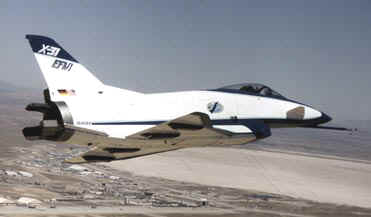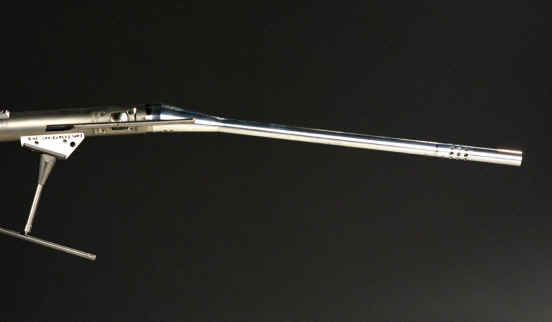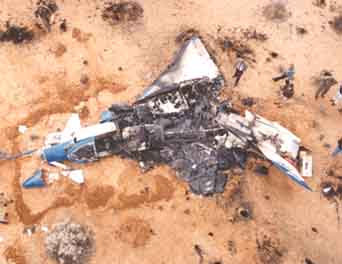 | Check-Six.com | |
Offering Aviation History & Adventure First-Hand! | ||
| ||||||||||
The Crash of the X-31A | ||||||||||||||||
| The Best of Best Worlds... | |
 The collaborative American-German Rockwell-Messerschmitt-Bölkow-Blohm (MBB) X-31 ''Enhanced Fighter Maneuverability'' program was designed to test fighter thrust vectoring technology. Thrust vectoring allows the X-31 to fly in a direction other than where the nose is pointing, resulting in significantly more maneuverability than most conventional fighters. An advanced flight control system provides controlled flight at high angles of attack where conventional aircraft would stall. The collaborative American-German Rockwell-Messerschmitt-Bölkow-Blohm (MBB) X-31 ''Enhanced Fighter Maneuverability'' program was designed to test fighter thrust vectoring technology. Thrust vectoring allows the X-31 to fly in a direction other than where the nose is pointing, resulting in significantly more maneuverability than most conventional fighters. An advanced flight control system provides controlled flight at high angles of attack where conventional aircraft would stall. Two X-31s were built, and over 500 test flights were carried out between 1990 and 1995. The X-31 featured fixed strakes along the aft fuselage, as well as a pair of movable computer-controlled canards to increase stability and maneuverability. There are no horizontal tail surfaces, only the vertical fin with rudder. Pitch and yaw are controlled by the three paddles directing the exhaust (thrust vectoring). Eventually, simulation tests on one of the X-31s showed that flight would have been stable had the plane been designed without the vertical fin, because the thrust-vectoring nozzle provided sufficient Yaw and pitch control. A Multi-Million Dollar "Oops"... The X-31 has three paddles mounted around the engine nozzles to redirect the flow of exhaust gases. The moveable nozzles provide more control and maneuverability at high angles of attack when normal flight control surfaces are less effective. Information gained from the X-31 program is planned to be used for future application to highly-maneuverable aircraft. For the test program two X-31 aircraft were built. | |
| |
German Federal Ministry of Defense test pilot Karl-Heinz Lang, assigned to the X-31 International Test Organization (ITO) at Dryden, had just completed a series of test points on the 292nd flight of aircraft No. 1 and was headed back to the Edwards area when he noted conflicting air data displays and a Master Caution warning. This was followed by uncommanded and diverging pitch oscillations. The aircraft then became uncontrollable and Lang safely ejected at 18,000 ft. and parachuted to the ground A Mishap Investigation Board studying the cause of the X-31 experimental aircraft accident concluded that an accumulation of ice in or on the unheated pitot-static system on the aircraft provided false airspeed information to the flight control computers, causing the aircraft to go out of control and crash. The aircraft was operated by an International Test Organization (ITO) located at NASA's Dryden Flight Research Center, Edwards, Calif. It was being flown back to Edwards Air Force Base following a research flight when it departed from controlled flight at an altitude of 20,000 feet and crashed near the northern boundary of Edwards. The pilot, Karl-Heinz Lang, Federal Republic of Germany, ejected safely.  The pitot-static pressure system, using a small tube called a Kiel probe at the nose of the aircraft, provided air speed data to instruments in the cockpit, the aircraft's flight control computers, and to the mission control center monitors at Dryden. The pitot-static pressure system, using a small tube called a Kiel probe at the nose of the aircraft, provided air speed data to instruments in the cockpit, the aircraft's flight control computers, and to the mission control center monitors at Dryden.Near the final portion of the approximately 43-minute flight, ice formed in or around the pitot tube. This led to a false reading of total air pressure data and caused the aircraft's flight control system to automatically misconfigure for a lower speed. The aircraft suddenly began oscillating in all axes, pitched up to over 90 degrees angle of attack and became uncontrollable, prompting the pilot to eject. The Board recommended that training be conducted on the system safety analysis process, that procedures be implemented to assure all test team members receive configuration change notices, and that improvements be made in the remaining X-31 to prevent similar single-point failures from causing catastrophic consequences. The X-31 was being flown to study the use of thrust vectoring as a way of enhancing the maneuverability of future fighter aircraft. The project was managed by the Advanced Research Projects Agency (ARPA), and included participation by NASA, the U.S. Navy, U. S. Air Force, Rockwell Aerospace, the Federal Republic of Germany and Daimler-Benz (formerly Deutsche Aerospace). Coincidentally, the incident flight was to have been the final scheduled mission for the No. 1 aircraft. The aircraft was to have entered phased maintenance and then remain on the ground pending program conclusion or possible follow-on research. | |

A overhead view of the X-31's crash site
We are currently searching for more photos of the crash site taken during the investigation. If you have any - please contact us. | |
| |
|